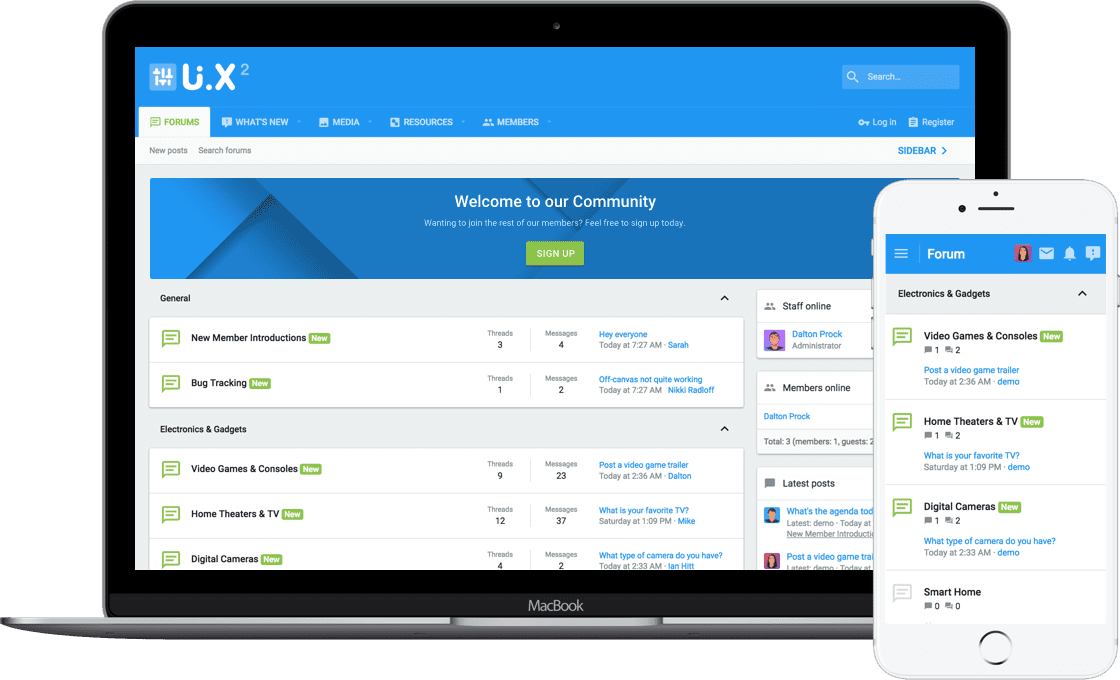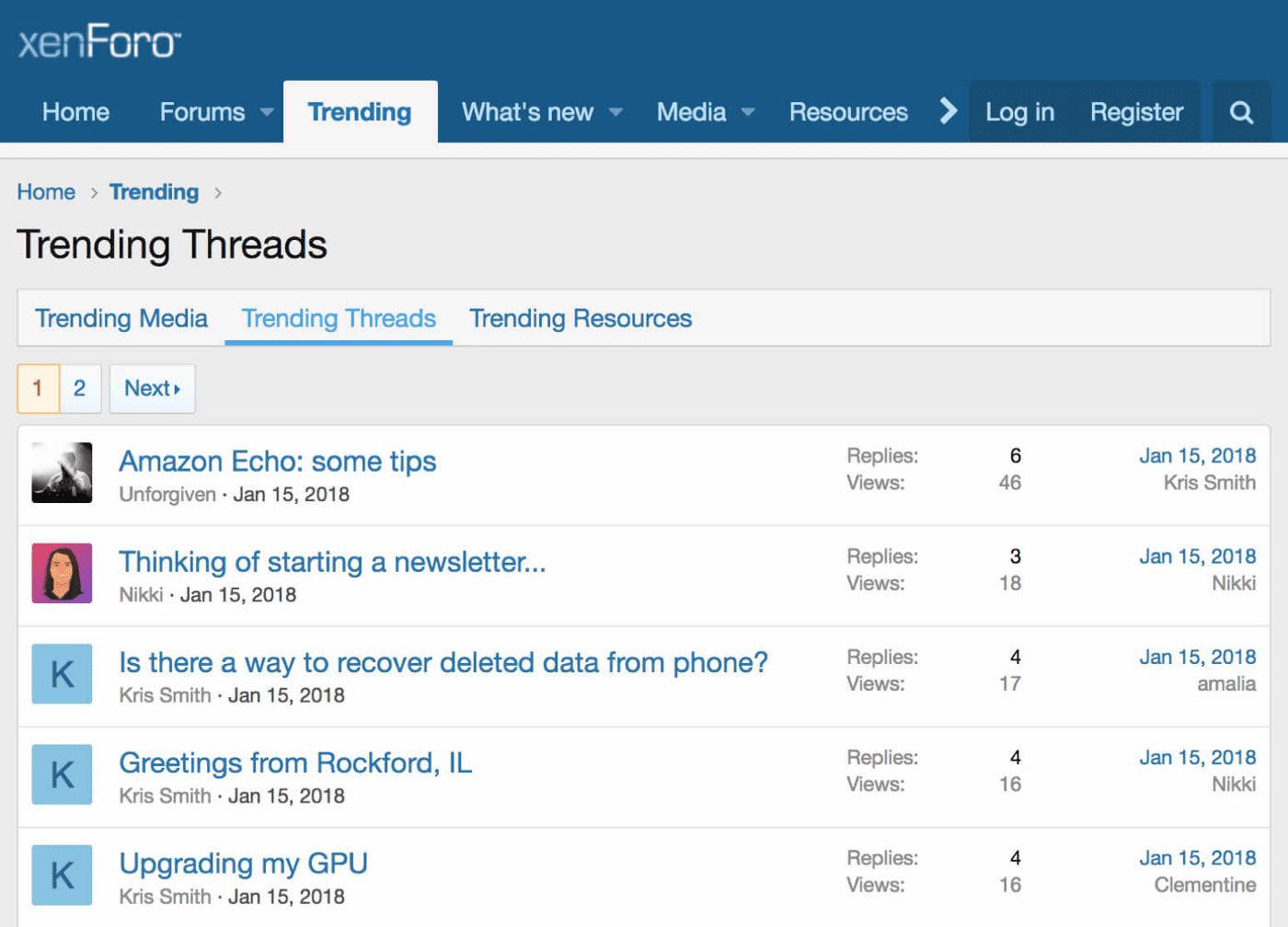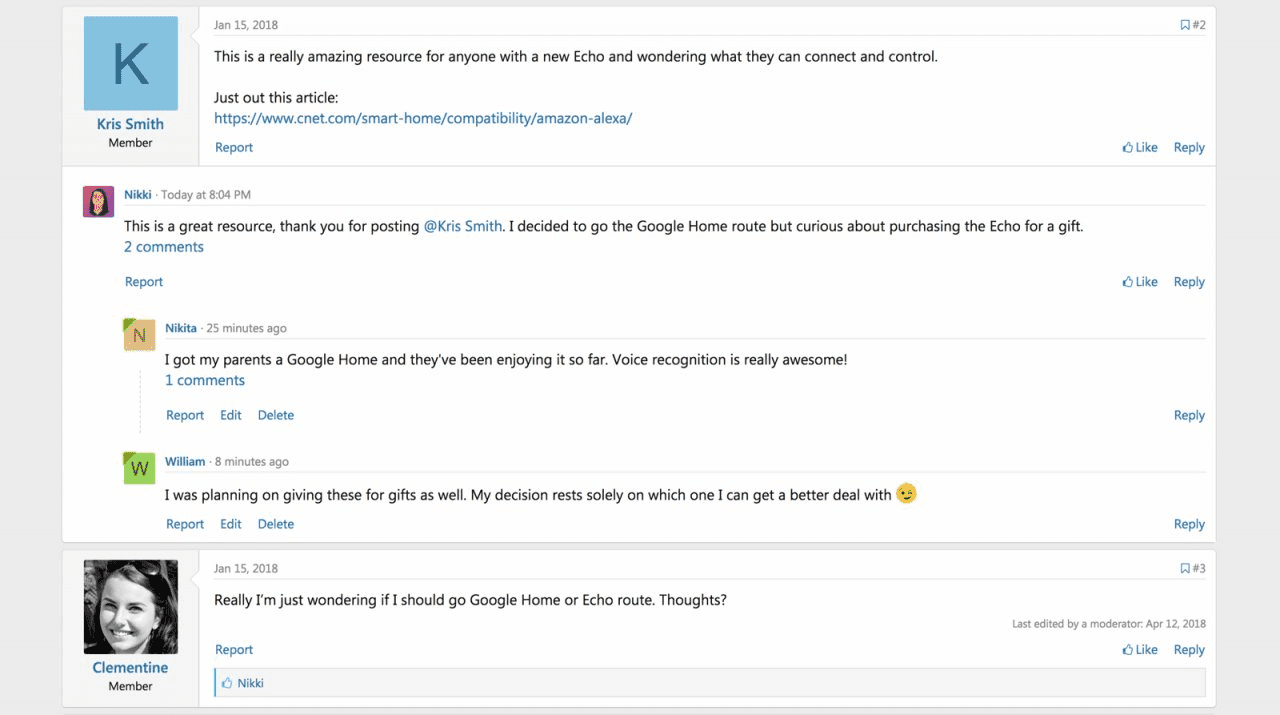Share This Article
A brief history of UX improvements focused on modernizing and improving classic forum discoverability techniques that XenForo software and others have been using for decades.
Introductions
The discussions within your community are one of your most valuable assets. They are key to driving engagement across the board. Messages, posts, conversations, media items, and similar, are the fundamental medium all communities use to discuss, share, question, and ideate.
At Audentio, community is our most critical focus, and so it has been of the utmost importance from our inception that our partners and the communities we build have the most convenient, most useful, and most relevant content discoverability and creation experiences.
This article will briefly outline the journey our company specifically has made over the years in tackling the issue of content creation, organization, and discoverability as it pertains to online communities.
Overview of forum interface history
Historically, online communities have relied on the features and default experiences of whatever out-of-the-box software they purchase or use, the theming system and third-party add-ons that software allows, and whatever is possible to be customized to accomplish the experience that is right for them. But for the most part, communities would always tend to settle on a standard experience which we refer to as the “Traditional Forum Experience”.
What is this Traditional Forum Experience?
We talk in greater detail about present day improvements we’ve made to dramatically improve the online community experience in a separate piece, but it is worth defining quickly what a “Traditional Forum Experience” is as we define it.
In a nutshell, traditional online communities organize their content into folders, also known as categories, sub-forums, nodes, discussion areas, and the like. These would be listed in an area called the forum home, forum list, category list, or topic list. And this page was almost always made the homepage.

From here, you’d have to click into these forum topics, click in into threads, find relevant navigation links hidden throughout the interface, all before you could start engaging how you wanted. This format is not entirely user-friendly for new members and younger audiences have steered clear of this methodology as they are used to social media experiences, which focus on immediate satisfaction and the simplest of experiences. Forums cannot always be simple for various reasons, but we simply knew we could and needed to do something better.
Where our journey started
In many ways, throughout the years, we were guilty of perpetuating the status quo that forums and online communities have used for the last two decades and more, the Traditional Forum Experience as mentioned above. But we were always trying to do better and many of our attempts pushed the needle a bit further. Some were obvious solutions, but perhaps didn’t work in certain forums or on distributed server infrastructure (such as the neural network and advanced search technology that social media benefit from), while many other ideas we tried simply just did not work. As you will see, we kept searching, iterating and building.
We began looking for a better solution in around 2016 with a soccer/football community called BigSoccer.com. The challenge we encountered with BigSoccer.com was that they offered their community members a large number of discussion topics to meet the needs of the soccer world. For example, there are thousands of teams, dozens of countries, hundreds of leagues, and many of them intertwine with each other. To continue that example, consider the topic of specifically English football (soccer). You have discussions on the leagues within England such as the English Premier League, England’s official team, as well as all the players, coaches, staff, business, transfers, team relegations (when a team moves into a different league), and so much more. To make it more complex, England can play in European leagues as well as the World Cup and so much more. This precise problem exists for each and every country and concept in the world of soccer.
BigSoccer had thousands of areas of discussion, and we wanted to make it convenient and easy for users to find what they want to discuss and have their own area to discuss the nuances of that discussion topic. But we wanted to do so without making the experience so complex, so slow to load, and so many options to click, thus rendering community members with choice paralysis and deterring them from engaging at all. Looking back, we didn’t solve this for that community. To be true, we would love to see what we can do on this site now that we’ve gone through such a transformative and educational experience, which their community helped us to initially understand simply by highlighting the issue.
This project, BigSoccer, is what started us on the path towards addressing online community discoverability issues, and here is where that realization took us.
Products we built to address discoverability
July 28, 2016: Watched Forums After Registration

Watched Forums After Registration aimed at increasing user activity and engaging members by customizing what forums showed up to newly registered users and gave users the ability to search and find specific topics that interested them. The benefit here is that they would automatically watch threads in this areas, which would give them alerts and emails. Still a useful feature and concept which we used Twitter as inspiration for.
November 16, 2017: Nodes

The purpose of the nodes system was to create a visually engaging forum that would captivate users with styled forums into columns and grids, backgrounds, colors, icons, and more. We adapted past the creation of this system in the next version of UI.X, modernizing the forum list. This ended up not being the ideal setup for users because the forum list then takes up more space and is more difficult to navigate and discover new content. We’ve since avoided styling topics list arbitrarily as we never found that they increased engagement.
November 28, 2017: UI.X 2

UI.X 2 was released Nov 28, 2017. This framework is one of the most advanced XenForo styles because it allows users to have complete control over their theme through a large variety of choices in the appearance section of the admin control panel. The theme also improved on performance issues experienced in the default XenForo theme. It was, to the best of our ability, a near perfect implementation of the material spec from Google.
We’ve supported this product for the last three and a half years and growing. It has been purchased thousands of times and we use it for the core for every project we use XenForo with to this day.
April 2, 2018: Trending

The trending thread list was designed to help users quickly discover the most active and relevant content so they could find current information and get involved fast. We built this as a means to help users find content that was trending throughout the community. It supports various options and features such as position changes of each thread to gauge whether things were trending upward or downward. Plus, a way to tweak the trending algorithm to work better for a particular community by altering the various weights of posts, views, reactions, shares, and other metrics.
We also had a private trending option for big boards which offered better results but required more resources on the server to function.
September 20, 2018: Post Comments

This system helped to modernize the forum experience by keeping post replies inline so that the discussion was easy to follow. With Post Comments, users could comment on each other’s posts without disrupting the thread, having private conversations, or too many tangents in the main discussion. Users are familiar with and expect that type of discussion format as it is common on most social network platforms.
October 26, 2018: UI.X Pro
UI.X Pro takes many of the systems we’ve created for user engagement and experience and includes them in a single package. But most importantly, it specifically set forth a single configuration for your core forum user experience. This was our first step in taking the perspective that “customization over successful strategies” was not what we wanted to promote for our partners. This was when we fundamentally began rejecting ideas that were not backed by data specifically. We required that anyone who purchased this product would allow our team to install and configure.
UI.X Pro Report

We have rebuilt this into one of our more recent projects, but we also built a really cool probably unnoticed feature into UI.X Pro that attempted to give your forum experience a report. It asked questions and gave a score based on certain factors such as:
- Do you have too many forum topics?
- Do you have too many add-ons?
- Have you organized your theme correctly?
- Are there too many root navigation links?
- Are certain critical board options configured?
- And much more
UI.X Pro was designed with the ideal approach for your forum in mind to increase community interaction, offer a high-quality user experience, and increase earning potential. The idea behind it, however, was something that changed our way of thinking for the better. Communities across the board were happy with UI.X Pro because they saw an improvement in their engagement numbers. Nothing insane, but it proved the idea we had fundamentally in forum user experience was in the right direciton.
December 13, 2018: Topics
This was our first idea we attempted to build that was large and attacked the fundamental problem with discoverability on forums. This system was designed to support the idea that threads could live under multiple topics, as opposed to the traditional idea of each discussion living under one topic. We had a sidebar widget that would allow users to select more than one topic and the content feed would display all the threads matching that criteria.
Back to our BigSoccer example, if a user wanted to create a discussion on Liverpool F.C. transferring a particular player, that user could tag their discussion with different Topics, such as “England”, “Premier League”, “Champions League”, “Transfers”, or whatever was relevant to that specific discussion and not only under the “England Premier League” forum topic. As a consequence of supporting this extra functionality, a user who was trying to discover discussions on relevant transfers on a particular day might see additional topics that might not have existed if the user creating the discussion simply organized it somewhere else.
There were so many great ideas we had for this project, and the premise was correct, but we ran into a few key issues:
- The software we built Topics into fundamentally just did not support this idea. Every feature, from search, to permission systems, to add-ons and more, simply made building this seamlessly an uphill battle. One we would never ultimately win.
- The data structures would begin to fight with one another. Tags, thread prefixes, forum nodes, thread fields, and so many other systems that help with discoverability simply were at odds with the idea of Topics. We thought about using prefixes, but they aren’t well-suited for this issue because you can’t have multiple prefixes, and prefixes can’t have permissions (such as private prefixes). We also considered using tags, but tags can be created by anyone and we want to be able to control what options users have for filtering. Topics had a mission to lessen the need for all the different organizational hierarchies, but since too many platforms used these features, we had to keep them.
- Existing platforms used traditional experiences already and the idea of taking an existing forum and flipping its content discoverability model on its head was concerning to us and to our clients, and rightfully so. We even at some point decided to only promote Topics to brand new forums. Which actually worked quite well, however it was not enough to force existing communities to switch.
- Despite attempts to make it convenient for the user creating the discussion, they ended up mostly just picking one topic anyway and not taking advantage of the fact they could add their thread to more than one.
- Community managers and administrators could not grasp the concept as we were unable to communicate the idea effectively. We tried videos, examples, articles, but the idea of the Traditional Forum Experience was too familiar and the product we built was not compelling enough. Reception was positive overall, but there were far too many areas we could not address that each user of the software brought up.
- The scope of the project grew too large to the point where we knew we didn’t have the resources to build through to completion. While we still do agree with many of the ideas we had in designing this product, to implement them correctly would require funds and other resources that made the idea overall completely untenable.
June 19, 2019: Featured Threads and Content
With Featured Threads and Content, the administrator or moderator of the community has a space for a curated content list with the ability to automatically feature user generated content that met certain criteria, thus reducing the time that the editorial team needed to come up with “homepage” content. Popular and valuable content can be promoted to this page through thread options automatically and promoted for a specified amount of time.
This was not a new idea, just a practical one that many people needed and were asking for. Users are creating content, why not have a way to promote that to the top? The problem here is that such a product that attempts to formalize user generated content is just never going to work, not without editing it anyways. Users of your platform cannot be expected to format content or write content in a way that a large audience will understand. Not under the standard of an editorial hat. Under the standard of the community as a whole, of course you would want this. But formatting it like an article, as this product and other products like WordPress bridges, have done, was missing the point.
December 4, 2019: Filter
This tool gives users of the community the ability to easily drill down to the content they want to see utilizing the filter widget or filter bar. We no longer had the ability to put content in two separate places, so we lost that feature from the Topics system. This add-on was also less about content organization and more about discoverability. It has options to filter by nodes, prefixes, specific users, and a variety of ascending and descending sort orders. We took advantage of how XenForo was built for the better, and just made it so content could be filtered faster and more conveniently and intuitively.
We also incorporated an idea of all threads in one place, latest threads, new posts, and trending threads into this system. By default, there are sort options, but we determined that users needed easier and more immediate access to these different content sorting options, rather than needing to manually filter every time.
In summary, we used the existing XenForo structures instead of taking new ones (like we did with Topics) andwe made the page update real-time. It seems odd to have gone through what we went through with Topics, just to end up with using XenForo vanilla with AJAX, but we learned that this was just the only way. While we still may agree with what Topics aimed to do, Filter was far more practical.
…and more
We built dozens of bridges, themes, small add-ons that would dynamically pull content, and so many prototypes that just never made it out of the planning stage. But I think the idea is communicated: we tried a lot. Much of what we built didn’t age well, but most of this all helped educate our team (and myself personally) on how forum discoverability needed to be done.
Building what must have been over 100 unique products that improved engagement gave us the foundation to take it one step further. And I don’t think we will ever stop improving, as ultimately that’s the point isn’t it? A community needs to be engaging to be effective. So anything, no matter how small, that can improve discourse needs to be considered. And we will continue on…
So, where are we now?
In recent months, we have had some light bulb moments. After spending all this time pouring blood, sweat, and tears into researching, prototyping, testing, polling different community members and communities, tearing down and starting over, we finally think we’ve come up with an extremely compelling solution to the Traditional Forum Experience problem. It’s for communities of all sizes, new and existing, and in different spaces with different needs, all of which has been a very difficult challenge to solve throughout this journey.
Our new solution is a step forward in what an online community should be. Here are some examples of the improvements:
- It has a universal create button that allows the creation of discussions, media items, social statuses, questions, or polls, in any part of the community.
- Users have multiple options for discovering content and the ability to set their favorite experience as a default so that they can easily return to it.
- A far more compelling mobile experience with improved navigation, cleaner components, and more intentionally considered user flows.
- Faster interactions and more immediate satisfaction such as infinite scrolling, ajax loading whenever possible, filtering systems real-time, and more.
And much more is listed in our separate piece. So many ideas, but we have a separate article where we discuss this entire system in greater detail.
Conclusion
Throughout this process, we’ve been determined to find the best way to make forums and online communities more engaging with better discoverability. Ideas we’ve considered and attempts we’ve made have been vast. From what layout makes users more likely to engage, to what configuration provides an experience that both traditional forum users and social media users are comfortable with, and beyond. Our hunt for idealistic and realistic solutions has been challenging for sure but also highly rewarding.
And we will continue to innovate wherever we can into the future.


